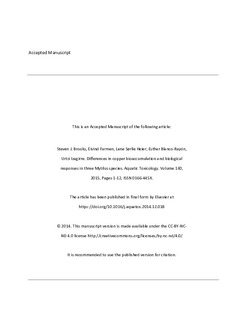| dc.contributor.author | Brooks, Steven | |
| dc.contributor.author | Farmen, Eivind | |
| dc.contributor.author | Heier, Lene Sørlie | |
| dc.contributor.author | Blanco-Rayon, Esther | |
| dc.contributor.author | Izagirre, Urtzi | |
| dc.date.accessioned | 2018-09-25T08:37:55Z | |
| dc.date.available | 2018-09-25T08:37:55Z | |
| dc.date.created | 2015-01-30T12:14:45Z | |
| dc.date.issued | 2015 | |
| dc.identifier.citation | Aquatic Toxicology. 2015, 160, 1-12. | nb_NO |
| dc.identifier.issn | 0166-445X | |
| dc.identifier.uri | http://hdl.handle.net/11250/2564262 | |
| dc.description.abstract | Mytilus species are important organisms in marine systems being highly abundant and widely distributed along the coast of Europe and worldwide. They are typically used in biological effects studies and have a suite of biological effects endpoints that are frequently measured and evaluated for stress effects in laboratory experiments and field monitoring programmes. Differences in bioaccumulation and biological responses of the three Mytilus species following exposure to copper (Cu) were investigated. A laboratory controlled exposure study was performed with three genetically confirmed Mytilus species; M. galloprovincialis, M. edulis and M. trossulus. Chemical bioaccumulation and biomarkers were assessed in all three Mytilus species following a 4 day and a 21 day exposure to waterborne copper concentrations (0, 10, 100 and 500 μg/L). Differences in copper bioaccumulation were measured after both 4 and 21 days, which suggests some physiological differences between the species. Furthermore, differences in response for some of the biological effects endpoints were also found to occur following exposure. These differences were discussed in relation to either real physiological differences between the species or merely confounding factors relating to the species natural habitat and seasonal cycles. Overall the study demonstrated that differences in chemical bioaccumulation and biomarker responses between the Mytilus spp. occur with potential consequences for mussel exposure studies and biological effects monitoring programmes. Consequently, the study highlights the importance of identifying the correct species when using Mytilus in biological effects studies. | nb_NO |
| dc.language.iso | eng | nb_NO |
| dc.publisher | Elsevier | nb_NO |
| dc.rights | Attribution-NonCommercial-NoDerivatives 4.0 Internasjonal | * |
| dc.rights.uri | http://creativecommons.org/licenses/by-nc-nd/4.0/deed.no | * |
| dc.title | Differences in copper bioaccumulation and biological responses in three Mytilus species | nb_NO |
| dc.title.alternative | Differences in copper bioaccumulation and biological responses in three Mytilus species | nb_NO |
| dc.type | Journal article | nb_NO |
| dc.type | Peer reviewed | nb_NO |
| dc.description.version | acceptedVersion | nb_NO |
| dc.source.pagenumber | 1-12 | nb_NO |
| dc.source.volume | 160 | nb_NO |
| dc.source.journal | Aquatic Toxicology | nb_NO |
| dc.identifier.doi | 10.1016/j.aquatox.2014.12.018 | |
| dc.identifier.cristin | 1212484 | |
| dc.relation.project | Norges forskningsråd: 160016 | nb_NO |
| cristin.unitcode | 7464,20,13,0 | |
| cristin.unitname | Økotoksikologi | |
| cristin.ispublished | true | |
| cristin.fulltext | postprint | |
| cristin.qualitycode | 2 | |

